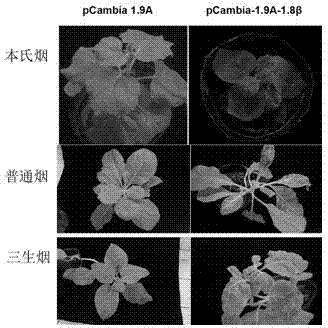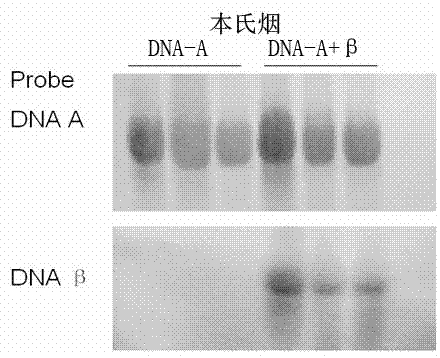Method for constructing cotton leaf curl Multan virus (CLCuMV) infectious vectors
A technology of cotton leaf curl virus and Multan cotton, which is applied in the field of genetic engineering, can solve the problems of expensive consumables, inconvenient promotion, and infecting plants, and achieve the effect of increasing applicability, small replication amount, and enhanced replication amount
- Summary
- Abstract
- Description
- Claims
- Application Information
AI Technical Summary
Problems solved by technology
Method used
Image
Examples
Embodiment 1
[0040] Example 1 Cloning and Determination of the Full Genome Sequence of Multan Cotton Leaf Curl Virus DNA A and DNAβ
[0041] 1. Extraction of total DNA of susceptible cotton
[0042] Weigh 0.1 g of cotton diseased leaves, add liquid nitrogen and grind to powder, add 1 ml of cell lysate (100 mM pH8.0 Tris-Hcl, 25 mM EDTANa 2 , 2M NaCl, 2% CTAB, 2%), add β-mercaptoethanol 2.3 μl / ml) before use, continue to grind, transfer to a 2 ml centrifuge tube, incubate at 65°C for 30 minutes, add 0.4 ml chloroform, and invert gently Mix well, centrifuge at 12000 rpm at 4°C for 5 minutes, absorb the supernatant, repeat 3 times, transfer the supernatant to a 1.5 ml centrifuge tube, add an equal volume of isopropanol, and let stand at -20°C for 1 hour. Then centrifuge at 12000 rpm for 5 minutes, discard the supernatant, wash the precipitate once with 75% ethanol, discard the ethanol, volatilize the residual ethanol in a vacuum dryer, and dissolve the precipitate in 40 ul ultrapure water. ...
Embodiment 2
[0046] Example 2 Construction of Multan Cotton Leaf Curl Virus DNA A and DNAβ Infectious Vectors
[0047] 1. Construction of Invasive Clones of DNA A Component
[0048] Agrobacterium-mediated invasive cloning of geminiviruses requires a full-length genome with more than 1.1-2.0 repeats and must include the 2 common regions of geminiviruses. Using the full-length DNA A clone as a template, GXA Xba1 F (5'-CCTGAAAGATCCTGTCTAGATTTGCAT-3', SEQ ID NO:9) and GXA sal1 R as primers, the reaction parameters are: 94°C for 3 min; 94°C for 45 sec, Anneal at 55°C for 30 sec, extend at 72°C for 3 min, 35 cycles, and finally extend at 72°C for 10 min, and use the PCR product Sal I and Xba After I double digestion, use the AxgenPCR cleaning kit to clean, and the same process Sal I and Xba The digested pCambia2300 was mixed at a molar ratio of 7:1, then T4 ligated and reacted overnight at 16°C. The next day, heat-shock the ligation reaction solution to transform Escherichia coli DH5α ...
Embodiment 3
[0054] Embodiment 3. Transformation of Agrobacterium by electroporation with infectious vector
[0055] pCambia-1.9A (DH5α), pCambia-1.8β (DH5α) and pCambia-1.9A-1.8β (DH5α) were inoculated with 5 ml of LB liquid medium containing Km (50 mg / L), and cultured overnight at 200 rpm at 37°C Afterwards, the cells were collected by centrifugation, and the plasmids were extracted using the Axgen plasmid extraction kit. Agrobacterium strain EHA105 was inoculated with 5 ml of YEP liquid medium containing Rif (50 mg / L), cultured at 200 rpm at 28°C for 48 hours, discarded the supernatant culture solution after centrifugation, resuspended the bacteria with sterile water, centrifuged again, discarded The supernatant was repeated 3-4 times to obtain EHA105 competent cells.
[0056] Take 2 μL of pCambia-1.9A, pCambia-1.8β, and pCambia-1.9A-1.8β plasmids, mix them with 200 μL of Agrobacterium EHA105 competent cells, and use a Bio-rad gene pluser xcell electric shocker with a voltage of 2400V...
PUM
 Login to View More
Login to View More Abstract
Description
Claims
Application Information
 Login to View More
Login to View More - R&D
- Intellectual Property
- Life Sciences
- Materials
- Tech Scout
- Unparalleled Data Quality
- Higher Quality Content
- 60% Fewer Hallucinations
Browse by: Latest US Patents, China's latest patents, Technical Efficacy Thesaurus, Application Domain, Technology Topic, Popular Technical Reports.
© 2025 PatSnap. All rights reserved.Legal|Privacy policy|Modern Slavery Act Transparency Statement|Sitemap|About US| Contact US: help@patsnap.com



